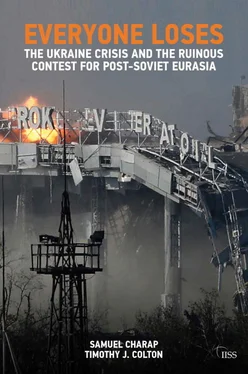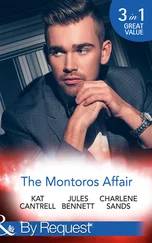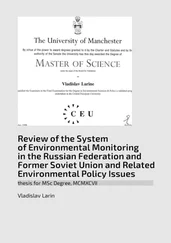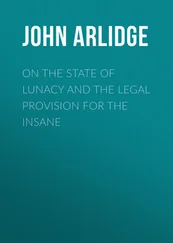Parsing through the various explanations is complicated by the wide range of justifications put forth by the participants themselves, particularly the leaders of Russia.
Serhy Yekelchyk, The Conflict in Ukraine: What Everyone Needs to Know (Oxford: Oxford University Press, 2015), p. 4.
Andrew Wilson, Ukraine Crisis: What It Means for the West (New Haven, CT: Yale University Press, 2014), p. vii.
John Mearsheimer, ‘Why the Ukraine Crisis Is the West’s Fault’, Foreign Affairs , vol. 93, no. 5, September/October 2014, pp. 82, 84.
Andrei Tsygankov, ‘Vladimir Putin’s Last Stand: the Sources of Russia’s Ukraine Policy’, Post-Soviet Affairs , vol. 31, no. 4, July 2015, p. 280.
Richard Sakwa, Frontline Ukraine: Crisis in the Borderlands (London: I.B. Tauris, 2015), p. 255.
Kathryn Stoner and Michael McFaul, ‘Who Lost Russia (This Time)? Vladimir Putin’, Washington Quarterly , vol. 38, no. 2, Summer 2015, p. 175.
Ibid. , p. 181.
Rajan Menon and Eugene Rumer, Conflict in Ukraine: The Unwinding of the Post-Cold War Order (Cambridge, MA: MIT Press, 2015), pp. xix, 162.
Phrase taken from the foundational argument about geo-economics in Edward N. Luttwak, ‘From Geopolitics to Geo-Economics: Logic of Conflict, Grammar of Commerce’, National Interest , no. 20, Summer 1990, pp. 17–23.
Lest this triad sound overly rationalistic, we concede that non-rational variables – such as arrogance, bureaucratic red tape, carelessness and sloth – also entered into the picture we describe. We are grateful to Neil MacFarlane for drawing our attention to this point. Our take, though, is that these factors were at work on all sides and did not tip the outcome in any one direction.
‘Text of Havel’s Speech to Congress’, 22 February 1990, https://www.washingtonpost.com/archive/politics/1990/02/22/text-of-havels-speech-to-congress/df98e177-778e-4c26-bd96-980089c4fcb2/.
James Baker, The Politics of Diplomacy: Revolution, War and Peace, 1989–1992 (New York: G.P. Putnam’s Sons, 1995), p. 158.
Ibid. , p. 247.
George H.W. Bush and Brent Scowcroft, A World Transformed (New York: Knopf, 1998), pp. 205–6.
Gorbachev quoted in Milan Svec, ‘The Prague Spring: 20 Years Later’, Foreign Affairs , vol. 55, no. 5, Summer 1988 , pp. 981–1001.
Mary Elise Sarotte, 1989: The Struggle to Create Post-Cold War Europe (Princeton, NJ: Princeton University Press, 2009), p. 91. Interestingly this heroic multinationalism, as Sarotte tags it, was also the dream of the socialistic dissidents who helped bring down East German Communism, and of liberal oppositionists in Poland and Czechoslovakia.
Within the Western alliance, Margaret Thatcher’s British government and, less so, François Mitterrand’s government in Paris had reservations about reunification but went along with it.
The sequence in which this was done was quite complex. For the details, see Mary Elise Sarotte, ‘Not One Inch Eastward? Bush, Baker, Kohl, Genscher, Gorbachev, and the Origin of Russian Resentment Toward NATO Enlargement in February 1990’, Diplomatic History , vol. 34, no. 1, January 2010, pp. 119–40.
Gorbachev ran the proposition of the Soviet Union joining NATO by George Bush later that month and in July, this time severing it from German unification. See Sarotte, 1989, chap. 5; Baker, The Politics of Diplomacy , pp. 251–2; Philip Zelikow and Condoleezza Rice, Germany Unified and Europe Transformed: A Study in Statecraft (Cambridge, MA: Harvard University Press, 1995), p. 280; James Baker, ‘Russia in NATO?’, Washington Quarterly , vol. 25, no. 1, Winter 2002, p. 102.
Bush and Scowcroft, A World Transformed , pp. 300–1.
‘Charter of Paris for a New Europe’, 1990, http://www.osce.org/mc/39516?download=true.
Baker, The Politics of Diplomacy , pp. 173, 196.
Bill Keller, ‘Gorbachev, in Finland, Disavows Any Right of Regional Intervention’, New York Times , 26 October 1989, http://www.nytimes.com/1989/10/26/world/gorbachev-in-finland-disavows-any-right-of-regional-intervention.html.
Gorbachev and Kissinger quoted in Bennett Kovrig, Of Walls and Bridges: The United States & Eastern Europe (New York: New York University Press, 1991), p. 360.
Stephen Kux, ‘Neutrality and New Thinking’, in Roger E. Kanet, Deborah Nutter Miner and Tamara J. Resler (eds), Soviet Foreign Policy in Transition (Cambridge: Cambridge University Press, 1992), pp. 110–13. The papers in this collection were written for an academic conference in 1990. By the time they came out, there was of course no such thing as Soviet foreign policy.
The treaty restoring Austria, under occupation since 1945, as a sovereign state was signed by the Allied powers and the Austrian government in May 1955. The Soviets made it a condition of signing that neutrality be written into the constitution, which was done by act of parliament five months later. Kissinger specifically suggested an Austrian-type arrangement for Czechoslovakia, Hungary and Poland. See Gerald B.H. Solomon, The NATO Enlargement Debate, 1990–1997: Blessings of Liberty (Washington DC: Center for Strategic and International Studies, 1998), p. 8. For broader discussion, see Richard Ned Lebow, ‘Understanding Change in International Politics: The Soviet Empire’s Demise and the International System’, in Richard Ned Lebow and Thomas Risse-Kappen (eds), International Relations Theory and the End of the Cold War (New York: Columbia University Press, 1995), pp. 155–6.
Joshua R. Itzkowitz Shifrinson, ‘Deal or No Deal? The End of the Cold War and the U.S. Offer to Limit NATO Expansion’, International Security , vol. 40, no. 4, Spring 2016, pp. 7–44; Baker quotation at p. 30. A well-argued alternative interpretation is Mark Kramer, ‘The Myth of a No-NATO-Enlargement Pledge to Russia’, Washington Quarterly , vol. 32, no. 2, April 2009, pp. 39–61.
‘It was definitely a violation of the spirit of the statements and assurances made to us in 1990.’ Maxim Korshunov, ‘Mikhail Gorbachev: I Am against All Walls’, Russia Beyond the Headlines, 16 October 2014, http://rbth.com/international/2014/10/16/mikhail_gorbachev_i_am_against_all_walls_40673.html.
Shifrinson, ‘Deal or No Deal?’, p. 40. Shifrinson also documents (p. 38) that some working-level officials in the Department of State and Pentagon penned briefs as soon as October 1990 about the desirability of keeping NATO’s door ajar and ‘not [giving] the East Europeans the impression that NATO is forever a closed club’.
Sarotte, 1989 , p. 200.
Читать дальше











